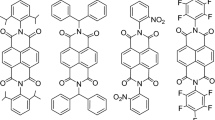Abstract
The molecular aggregation state of a porphyrin-perylenediimide dyad can be changed by treating with trifluoroacetic acid. Transmittance electron microscopy (TEM) images revealed that lamella microstructures were formed when the dyad precipitated from neutral solvent, but spherical nano-particles were obtained when precipitating from acidic solution. X-ray diffraction patterns showed that the lamella microstructures and the nanoparticles were polycrystalline and amorphous solids, respectively. By using rational perylenediimide and porphyrin as reference compounds, careful analyses on the UV-visible spectra of the dyad and the references under different conditions were conducted and the results demonstrated that both the porphyrin and perylendiimide subunits of the dyad took J-aggregation in neutral solvent, but after being treated with trifluoroacetic acid and chloroform solution, the perylenediimide subunit changed to an H-aggregation while the porphyrin subunits changed to a random packing mode.
Similar content being viewed by others
References
Miller M A, Lammi R K, Prathapan S, et al. A tightly coupled linear array of perylene, bisporphyrin, and phthalocyanine units that functions as a photoinduced energy transfer cascade. J Org Chem, 2000, 65: 6634–6649
Prathapan S, Yang S I, Seth J, et al. Synthesis and excited state photodynamics of perylene-porphyrin dyads. 1, Parallel energy and charge transfer via a diphenylethyne liker. J Phys Chem B, 2001, 105(34): 8237–8248
Yang S I, Prathapan S, Miller M A, et al. Synthesis and excited state photodynamics in perylene-porphyrin dyads. 2, Effects of porphyrin metalation state on the energy-transfer, charge transfer, and deactivation channels. J Phys Chem B, 2001, 105(34): 8249–8258
Yang S I, Lammi R K, Prathapan S, et al. Synthesis and excited state photodynamics of perylene-porphyrin dyads. 3, Effects of perylene, liker and connectivity on ultra-fast energy transfer. J Mater Chem, 2001, 11: 2420–2430
O’Neil M P, Niemczyk M P, Svec W A, et al. Picosecond optical switching based on biphotonic excitation of an electron donor-acceptor-donor molecule. Science, 1992, 257(5074): 63–65
Debreczeny M P, Svec W A, Wasielewski M R. Optical control of photogenerated ion pair lifetimes: an approach to a molecular switch. Science, 1996, 274(5256): 584–586
von der Boom T, Hayes R T, Zhao Y, et al. Charge transport in photofunctional nanoparticles self-assembled from zinc-5,10,15,20-tetrakis(perylenediimide)porphyrin building blocks. J Am Chem Soc, 2002, 124(32): 9582–9590
Li X Y, Sinks L E, Rybtchinski B, et al. Ultrafast aggregate-to-aggregate energy transfer with in self-assembled light harvesting columns of zinc phthalocyanine tetrakis(perylenediimide). J Am Chem Soc, 2004, 126(35): 10810–10811
Fuller M J, Sink L E, Rybtchinski B, et al. Ultrafast photoinduced charge separation resulting from self-assembly of a green perylene-based dye into π-stacked arrays. J Phys Chem A, 2005, 109(6): 970–975
Kelley R F, Tauber M J, Wasielewski M R. Linker controlled energy and charge transfer within chlorophyll trefoils. Angew Chem Int Ed, 2006, 45(47): 7979–7982
Tauber M J, Kelley R F, Giaimo J M, et al. Electron hopping in π-stacked covalent and self-assembled perylene-diimide observed by ENDOR spectroscopy. J Am Chem Soc, 2006, 128(6): 1782–1783
Ahrens M J, Kelley R F, Dance Z E X, et al. Photoinduced charge separation in self-assemled pentamers of 5,10,15,20-tetrakis (perylenediimide) porphyrin. Phys Chem Chem Phys, 2007, 9(12): 1469–1478
Kelley R F, Shin W S, Rybtchinski B, et al. Photoinitiated charge transport in supremolecular assemblies of 1,7-N,N′-tetrakis(zinc-porphyrin)-perylene-3,4:9,10-bis(dicarboximide). J Am Chem Soc, 2007, 129(11): 3173–3181
Yang X G, Sun J Z, Wang M, et al. A more efficient synthetic route to perylene-porphyrin arrays. Chin Chem Lett, 2003, 14(11): 1105–1108
Sun J Z, Yang X G, Li H Y, et al. An acid-base controlled fluorescence switch based on a free-base-porphyrin-perylene-diimide molecular array. Chem J Chin Univ, 2004, 25(11): 2148–2152
Sun J, Yang X, Wang M. Thin films of porphyrin-perylene molecular array fabricated by electrophoresis methodology. Chin Sci Bull, 2005, 50(19): 2157–2160.
Struijk C W, Sieval A B, Dakhorst J E J, et al. Liquid crystalline perylene diimides: Architecture and charge carrier mobilities. J Am Chem Soc, 2000, 122(45): 11057–11066
Cormier R A, Gregg B A. Self-organization in thin films of liquid crystalline perylene-diimides. J Phys Chem B, 1997, 101(51): 11004–11006
Liu S G, Sui G D, Cormier R A, et al. Self-organizing liquid crystal perylene diimide thin films: Spectroscopy, crystallinity and molecular orientation. J Phys Chem B, 2002, 106(6): 1307–1315
Sui G, Orbulescu J, Mabrouki M, et al. Self-assembly of liquid crystal semiconductor molecules at the air/water interface. J Phys Chem B, 2002, 106(36): 9335–9340
Rybtchinski B, Sinks L E, Wasielewski M R. Combining light-harvesting and charge separation in a self-assembled artificial photosynthetic system based on perylenediimide chromophores. J Am Chem Soc, 2004, 126(39): 12268–12269
Hoebin F J M, Jonkheijm P, Meijer E W, et al. About supramolecular self-assemblies of π-conjugated systems. Chem Rev, 2005, 105(4): 1491–1546
Kasha K, Rawls H R, El-Bayoumi. The exciton model in molecular spectroscopy. Pure Appl Chem, 1965, 11: 371–390
Choi M Y, Pollard J A, Webb M A, et al. Counterion-dependent excitonic spectra of tetra(p-carboxyphenyl)porphyrin aggregates in acidic aqueous solution. J Am Chem Soc, 2003, 125(3): 810–820
Okada S, and Segawa H. Substituent-controlled excitation in J-aggregates of protonated water-insoluble porphyrins. J Am Chem Soc, 2003, 125(9): 2792–2796
Author information
Authors and Affiliations
Corresponding author
Additional information
Supported by the National Natural Science Foundation of China (Grant Nos. 50573065 and 50573019) and the Natural Science Foundation of Zhejiang Province of China (Grant No. Z406018)
About this article
Cite this article
Xie, B., Cao, Y., Sun, J. et al. Change in aggregation state of a porphyrin-perylene-diimide dyad induced by trifluoroacetic acid. Chin. Sci. Bull. 53, 209–214 (2008). https://doi.org/10.1007/s11434-007-0496-2
Received:
Accepted:
Issue Date:
DOI: https://doi.org/10.1007/s11434-007-0496-2




